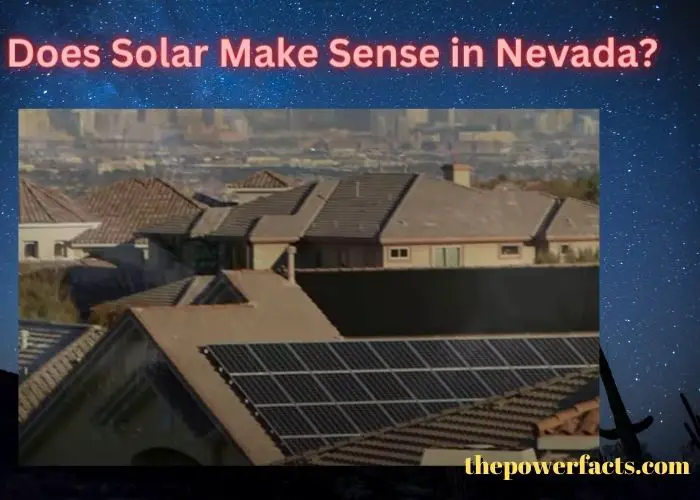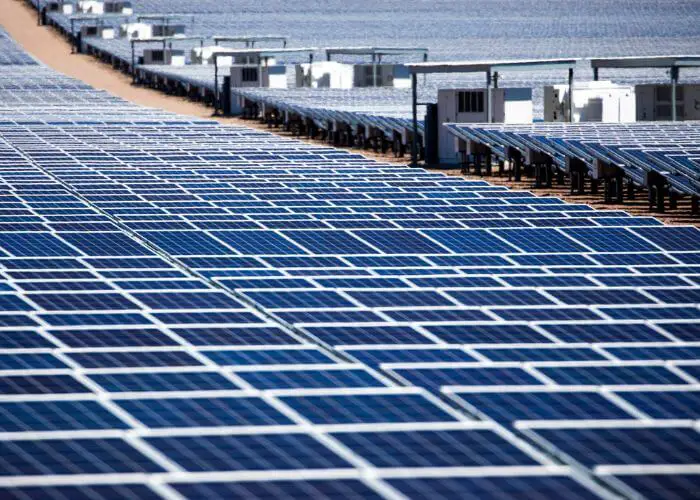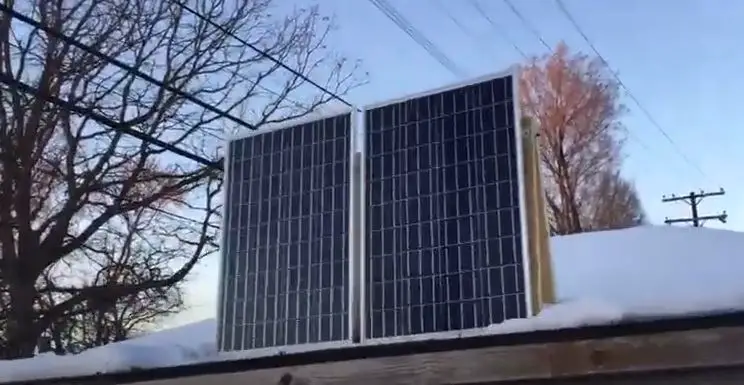With nearly 300 days of sunshine each year, it’s no surprise that solar energy is a popular choice for homeowners in Nevada. Solar panels can be used to generate electricity, heat water or pool, and even cool your home. With the high cost of traditional energy sources, solar is an attractive option for many Nevadans.

Solar power is a hot topic in Nevada these days. With the state’s sunny climate and abundance of open space, it’s no wonder that solar energy is being touted as a viable option for powering homes and businesses. But is solar really a good fit for Nevada?
There are definitely some advantages to going solar in Nevada. Solar panels can produce a lot of energy in our state, thanks to all those sunshine hours. And since we have plenty of room to install them, there’s very little land impact associated with solar power generation.
But there are also some challenges to using solar power in Nevada. One big one is the cost of upfront investment. Solar panels and other equipment can be pricey, so you need to make sure you do your homework before making the switch. You also have to decide which side of your house is best for solar.
Additionally, while solar power production doesn’t create any air pollution, the manufacturing process for solar panels can be quite polluting. So it’s important to consider the whole life cycle of a solar panel before making a decision about whether or not to go solar. You also have to know how to protcet from rain. Ultimately, whether or not switching to solar makes sense for you will depend on your individual situation and needs.
If you have the upfront cash and are committed to doing your research, going solar could be a great way to save money on your energy bills and help out the environment too.
Is Solar in Nevada Worth It?
There are many reasons to consider solar power in Nevada. The state has an average of 300 sunny days per year and plenty of wide open spaces that make it ideal for large-scale solar installations. Solar energy is also a renewable resource that can help reduce dependence on fossil fuels, and it doesn’t produce harmful emissions like some other forms of generation.
Solar power has been growing in popularity in recent years as the technology has become more efficient and less expensive. In 2016, Nevada ranked 4th in the nation for installed solar capacity with 1,265 megawatts (MW) online. This was enough to power over 251,000 homes, or about 3% of households in the state.1
The cost of solar panels has fallen by more than 70% since 2010,2 making it an increasingly attractive option for homeowners and businesses alike. And while the upfront investment can be significant, there are a number of financial incentives available that can make going solar more affordable. These include federal tax credits, net metering policies from utilities, and rebates from state governments.3
In short, there are many reasons to consider solar power in Nevada. It’s a renewable resource that can help reduce dependence on fossil fuels, it doesn’t produce harmful emissions, and the costs have come down significantly in recent years thanks to advances in technology. With ample sunshine and plenty of wide open spaces, Nevada is well-suited for large-scale solar installations.
Is Solar Popular in Nevada?
Solar power is becoming increasingly popular in the state of Nevada. There are a number of reasons for this, including the state’s abundance of sunlight and its commitment to renewable energy.
Nevada has some of the best solar resources in the country, receiving an average of 300 days of sunshine per year.
This makes it an ideal location for solar power generation. In addition, the state has set a goal of generating 25% of its electricity from renewable sources by 2025. Solar power will play a major role in meeting this goal.
There are already a number of large-scale solar facilities operating in Nevada, and many more are under development. These projects are providing clean, emissions-free electricity to homes and businesses across the state. As solar technology continues to improve and become more affordable, it is likely that even more Nevadans will choose to go solar in the years ahead.

Is Solar a Good Idea in Las Vegas?
Solar energy is a good idea in Las Vegas for a number of reasons.
| First | The city gets an average of 300 days of sunshine per year, making it an ideal location for solar panels to capture sunlight and convert it into electricity. |
| Second | The hot desert climate means that solar panels can generate electricity even on extremely sunny days. |
| Third | Las Vegas has a large amount of open space that can be used for solar farms. And fourth, the state of Nevada offers a number of incentives for businesses and homeowners to install solar panels, including tax credits and rebates. |
Remember dirty solar panel can not produce same electricity then clean one.
Cost of Solar Panels in Nevada
According to Energy Sage, the average cost of solar panels in Nevada is $2.94 per watt. This means that a 6 kilowatt (kw) solar system would cost around $17,640 after federal tax credits. Solar panel costs have fallen significantly in recent years and continue to do so.
In 2010, the same 6 kw system would have cost nearly double at $33,000. The payback period for a solar investment in Nevada is around 7-9 years. This means that you would make your money back on your initial investment within 7-9 years and then have free electricity for the rest of the life of your system, which is typically 20-25 years.
Solar energy is a great way to save money on your electric bill, especially in a state like Nevada where sunlight is abundant. With the high upfront cost being offset by long-term savings, now is a great time to go solar!
How Much Energy Does a 7Kw Solar System Produce?

A 7kW solar system produces an average of 9,600 kilowatt-hours (kWh) of electricity per year. This is enough to power a typical home for about eight months. The amount of electricity produced by a solar system depends on many factors, including the time of year, the angle of the sun, and the weather.
Is Solar Worth It in Nevada?
Solar power is a hot topic these days, and with good reason. It’s a clean, renewable source of energy that can help us reduce our reliance on fossil fuels. And in many parts of the country, it’s becoming more affordable as technology improves and incentives are offered.
But what about in Nevada? Is solar worth it here?
The short answer is yes!
Solar can be a great investment in Nevada for a number of reasons.
First, let’s look at the cost of solar panels. The price of solar has fallen dramatically in recent years, making it more affordable than ever before.
In fact, according to the Solar Energy Industries Association (SEIA), the average cost of installing a residential solar system has dropped by 50% since 2010. And with prices expected to continue falling, now is a great time to go solar in Nevada.
Second, there are ample sunlight hours in Nevada to make going solar worthwhile.
According to the National Renewable Energy Laboratory (NREL), Nevada receives an average of 5.5 hours of usable sunlight per day–plenty for powering your home with solar energy.
Average Cost of Solar Panels in Las Vegas
The average cost of solar panels in Las Vegas is $3.17 per watt. This means that the average 5kW system in Vegas will cost around $15,850 after rebates and incentives. Solar prices have been falling rapidly in recent years, and they are expected to continue to do so.
Incentives like the federal solar tax credit can make going solar more affordable. Solar is a great investment for anyone looking to save money on their energy bills and shrink their carbon footprint.
NV Energy
NV Energy is a public utility which provides electric service to more than 2.4 million customers in Nevada as well as natural gas service to more than 1.2 million customers in northern and southern Nevada. It is the largest provider of electricity in the state of Nevada. NV Energy is the result of the merger of two previous utilities, Sierra Pacific Power Company and Nevada Power Company, which occurred on July 1, 1999.
How Many Kwh Does a 1Kw Solar Panel Produce?

If you’re considering installing solar panels, you may be wondering how much electricity they’ll actually produce. This will depend on a number of factors, including the size of the panel (measured in watts) and the amount of sunlight it receives. But as a general rule of thumb, a 1 kW solar panel will generate around 1,400 kWh of electricity per year.
Solar panels usually come in different sizes, with the most common being between 250 watts and 400 watts. So if you have a 1 kW panel, that’s equivalent to four or five standard-sized panels. The average home in the United States uses about 930 kWh of electricity per month, so a 1 kW solar panel would cover around 15% of that usage.
Of course, the amount of sunlight your panels receive will also affect how much electricity they generate. If you live in an area with lots of sun year-round (like California), you can expect to generate more electricity than someone who lives in a cloudier region (like Washington state). And during the summer months when there are longer days and more daylight hours, your system will produce even more power than usual.
So how do you know how much power your particular solar panel will generate? The best way is to look at its performance warranty from the manufacturer. This should give you a good idea of what kind of output to expect under different conditions.
Tesla Solar
As the world progresses, so does technology. With new advancements comes new companies and products that aim to make our lives easier, and more sustainable. Tesla is one of those companies.
They not only create electric cars, but also solar roofs that are designed to look like a traditional roof, but with solar panels built in. Tesla’s solar roofs are made up of tempered glass tiles that are extremely durable and can withstand heavy weather conditions. The solar cells are invisible to the naked eye, which gives the roof a clean and uniform look.
Not only do these roofs provide your home with renewable energy, but they also increase the value of your home. Solar roofs are a great way to reduce your carbon footprint and save money on your energy bill. If you’re looking for a way to go green and save some money, Tesla’s solar roofs are definitely worth considering!
FAQs
How Much Does a 4Kw Solar System Produce Per Day?
A 4kW solar system will produce an average of 16 kilowatt-hours (kWh) of electricity per day, depending on the time of year and weather conditions. In the summer, when the sun is out for longer each day, a 4kW system can generate up to 30 kWh per day. However, in the winter months, production will be lower due to shorter days and more cloud cover.
To find out exactly how much your 4kW system is producing each day, you can check the output readings from your inverter or solar monitoring system. These devices will give you real-time data on how much power your system is generating.
Why is Nevada Good for Solar Power?
There are many reasons Nevada is good for solar power. First, the state has an average of 300 sunny days per year. This means that there is a lot of potential for solar energy production.
Additionally, the state has a large amount of open space which makes it easier to install solar panels. There are also many incentives for installing solar panels in Nevada, including tax breaks and rebates.
Conclusion
In short, solar makes a lot of sense in Nevada. The state is sunny and has high electricity prices, making it an ideal place to go solar. There are also a number of incentives available to encourage people to switch to renewable energy sources like solar.